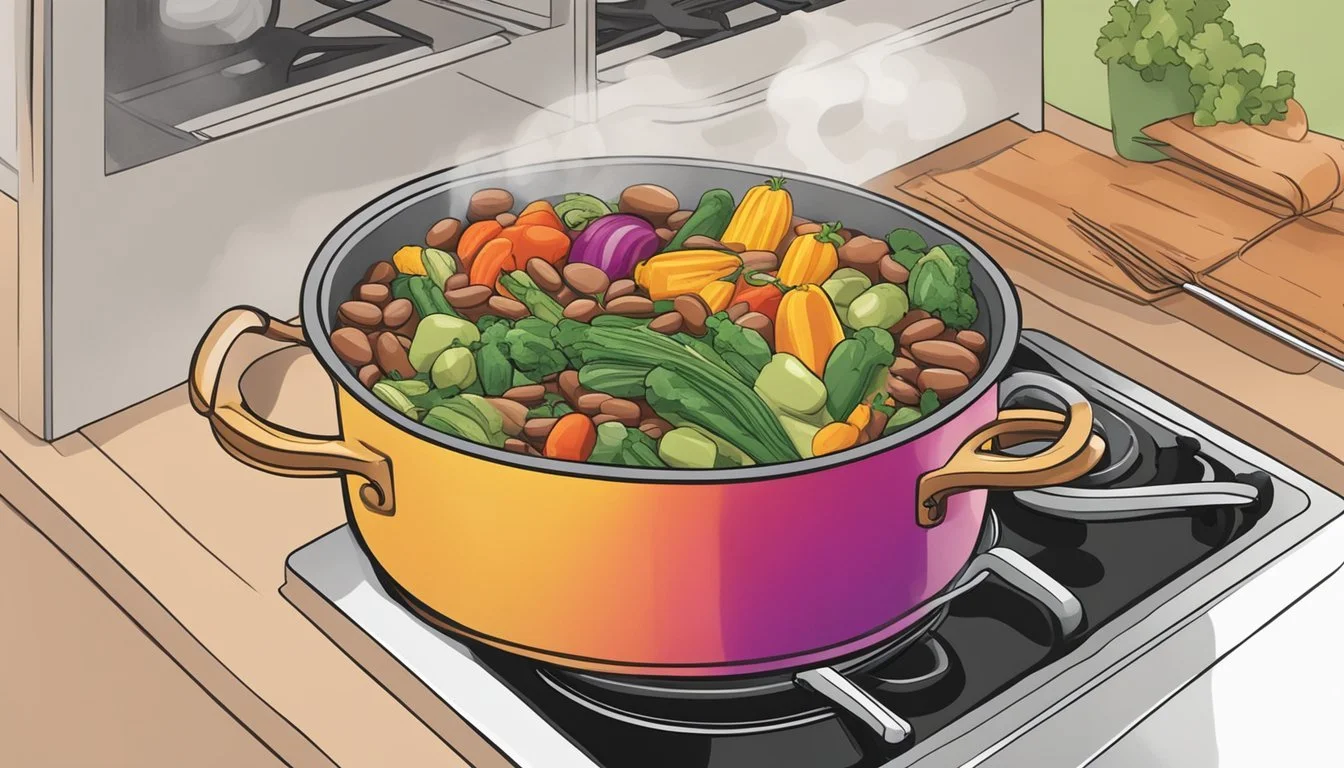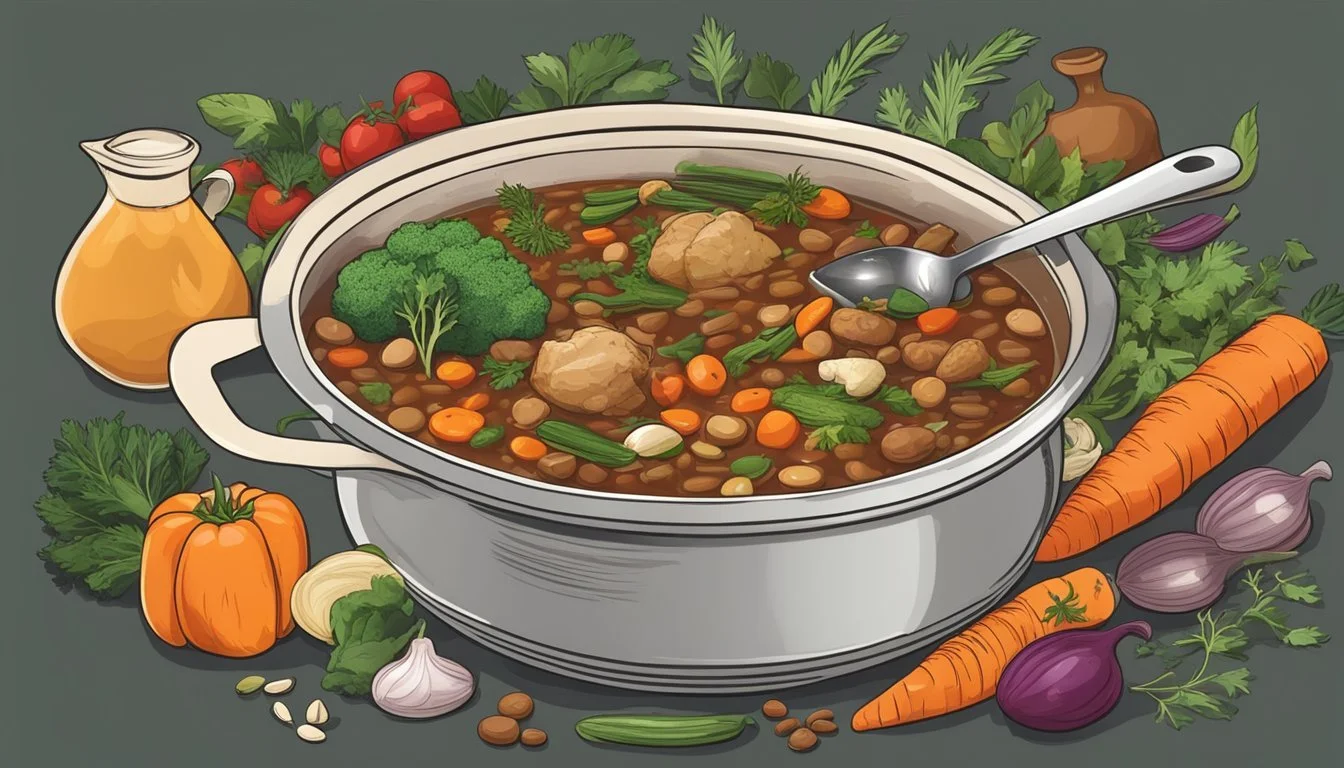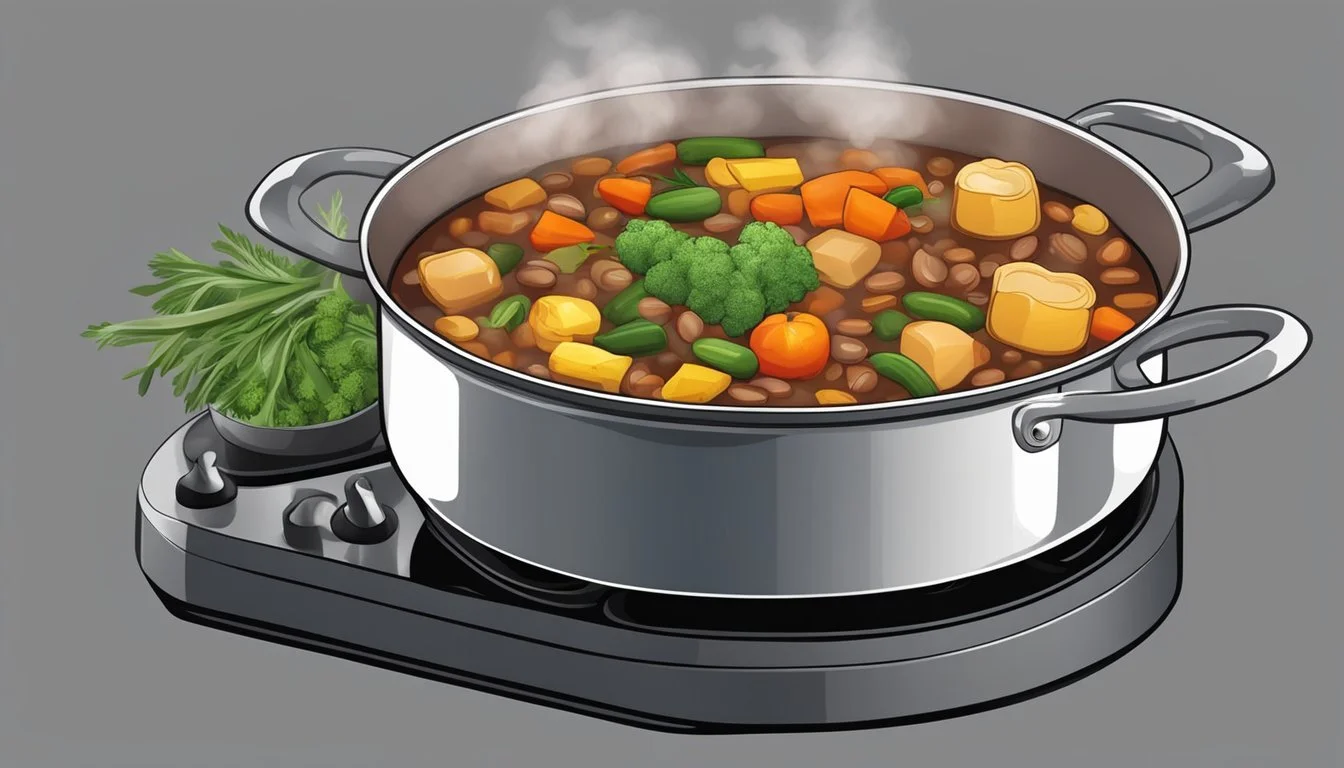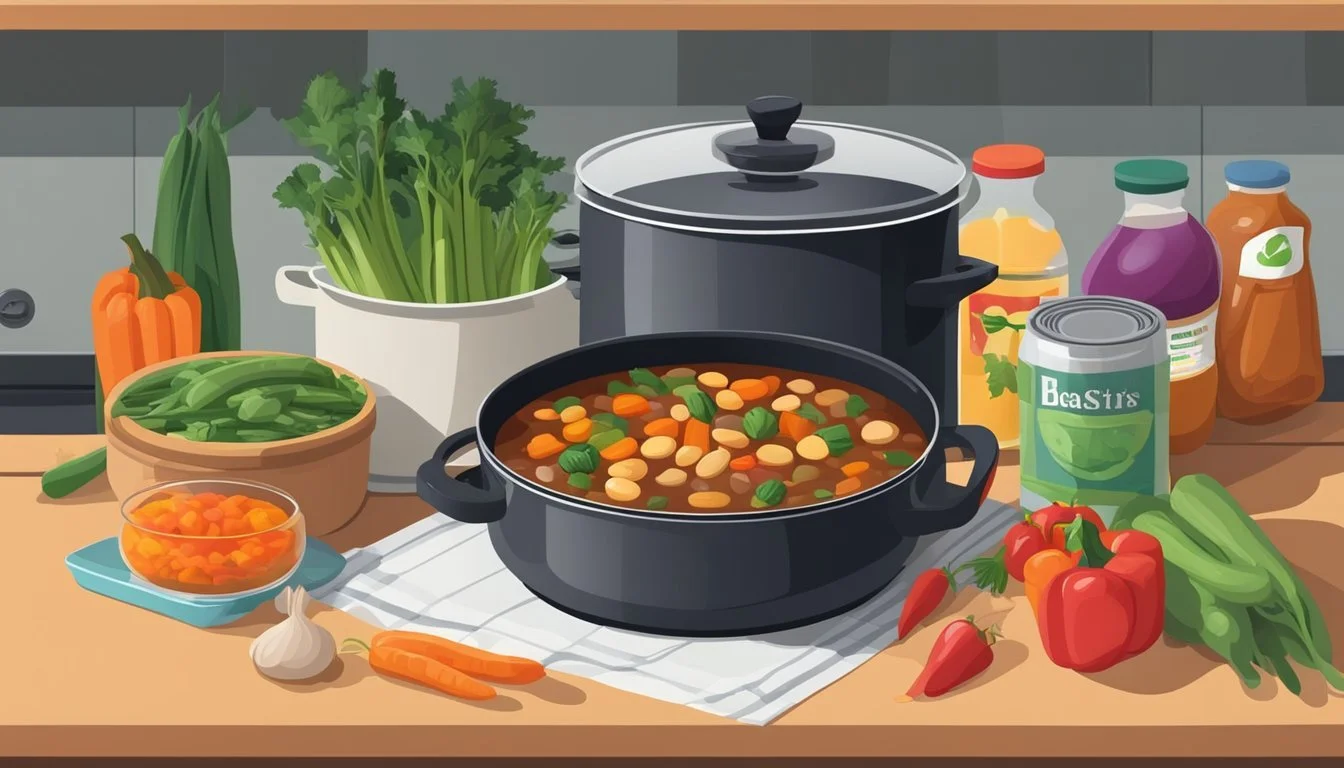How to Cook with Bush's Beans for Hearty Stews
A Guide to Rich, Flavorful Meals
Cooking hearty stews (What wine goes well with stews?) with Bush's Beans is a comforting and satisfying way to feed a family or crowd, especially during the colder months. Rich in protein and fiber, beans are not only nutritious but also incredibly versatile, blending well with a variety of ingredients to create dishes that are both filling and flavorful. Their ease of use makes them an excellent choice for quick, one-pot meals like cowboy stew, a robust dish that often combines beans with meats and vegetables for a well-rounded meal.
An easy recipe that showcases the convenience and taste of beans can become a staple in any home cook's repertoire. Bush's Beans, known for their quality and variety, can amplify the taste and texture of stews. By incorporating these beans into a stew, one can add depth and richness without spending hours in the kitchen. Such recipes often call for simple, readily available ingredients, and they can be easily adapted to suit different dietary preferences or to work with ingredients that are on hand.
Stews with Bush's Beans can cater to a wide array of tastes, from smoky and meaty flavors reminiscent of campfire cooking to lighter, Mediterranean-inspired variations with beef and vegetables. No matter the style, stews made with Bush's Beans promise a fulfilling and enjoyable eating experience. The addition of beans not only thickens the stew to the desired consistency but also complements the other components, resulting in a dish that is as heartwarming as it is hearty.
Choosing the Right Ingredients
The success of a hearty stew largely depends on the quality and compatibility of its components. Selecting the most fitting ingredients ensures a balanced, nutritious, and savory dish.
Types of Beans
Beans are the heart of the stew, contributing fiber and protein with low levels of saturated fat and cholesterol. Bush's Beans offers a variety of canned beans that are convenient and flavorful. Options include:
Kidney beans: Robust and ideal for absorbing spices.
Black beans: Offer a slightly sweet taste, perfect for Southwestern stews.
Great Northern beans: Mild in flavor, they're great for thickening stews.
Navy beans, cannellini beans, and pinto beans: All versatile choices suited for variety of recipes.
Remember that canned beans also contain sodium, so adjust your seasoning accordingly.
Protein Sources
Hearty stews require a solid protein base to create a satisfying meal. Lean proteins like ground turkey or chicken minimize saturated fat, while options like bacon, sausage, ham, and chorizo add bold flavors but also increase fat content.
Vegetables and Herbs
Vegetables and herbs infuse the stew with essential vitamins and flavors. Include a variety of vegetables such as:
Onions and garlic: Foundation for flavor.
Carrots and sweet potatoes: Naturally sweet, high in fiber and vitamins.
Spinach, broccoli, and peas: Green veggies add color and nutrition.
Bell peppers: Contribute a slight sweetness and crisp texture.
For herbs, thyme, oregano, bay leaves, and red pepper flakes offer a range of flavors to enhance the stew.
Flavor Enhancers
Seasonings and spices provide depth and complexity to stews. Use cumin, paprika, and bay leaf to boost the savory notes. For a punchier profile, incorporate pepper flakes and fresh cracked pepper.
Broth and Liquids
The stew's broth acts as a carrier for flavor and a medium for cooking its ingredients. Choose a broth that complements your main ingredients:
Beef broth: Rich and deep, good for stews with red meat.
Chicken broth: Lighter, suitable for poultry-based stews.
Vegetable broth: Perfect for vegetarian stews.
Adding a splash of red wine can enhance the stew's richness.
Additional Ingredients
For added texture and interest, consider:
Rice: Absorbs flavor and adds carbohydrates.
Corn: Sweetness and crunch.
Cheese, sour cream, or guacamole: Can be served on the side for richness and flavor.
Always measure ingredients carefully to maintain nutritional balance and keep calorie count in check.
Preparation Techniques
Effective preparation techniques are essential for crafting a hearty stew with Bush's Beans that is both flavorful and satisfying. One must consider the type of beans used, the methods of cutting vegetables, and the varied cooking methods available to ensure the stew is cooked to perfection.
Soaking and Preparing Beans
To begin, dried beans require soaking, which can be done either overnight in cold water or using the quick-soak method where beans are boiled for a few minutes and then left to stand for an hour. Canned beans, like Bush's Beans, save time as they are pre-cooked and merely need to be rinsed before use. Proper preparation ensures beans cook evenly and contribute to the stew's creamy texture.
Bush's Beans Type Preparation Cooking Time Dried Beans Overnight soak or quick-soak then rinse 1-2 hours until tender Canned Beans Rinse None (add directly to stew)
Cutting and Dicing
For a more robust flavor, diced onions and other vegetables should be uniformly cut to ensure even cooking. A skillet is ideal for sautéing onions and vegetables like carrots and celery before incorporating them into the stew. Uniform pieces not only cook at the same rate but also improve the overall texture of the stew.
Cooking Methods
Various cooking methods can be employed when making a bean stew. For a quick stew, use a large pot on the stove, wherein ingredients like liquid, diced tomatoes, and Bush's Beans are simmered until thickened. To develop deeper flavors, a crockpot or instant pot can be used, which allows beans and other ingredients to cook slowly over several hours. Each method has its benefits: stovetop for speed and control, crockpot for convenience and flavor fusion, and instant pot for time-saving and preservation of nutrients.
Cooking Method Description Cooking Time Stove Simmer in a pot; provides control over the cooking process. Varies by recipe; usually 1-2 hours Crockpot Slow cook; allows flavors to meld together over time. 6-8 hours on low heat Instant Pot Pressure cook; rapid cooking while locking in flavors. 30-50 minutes depending on setting
By adhering to these preparation techniques, one can ensure a rich and delightful bean stew with an optimal balance of flavors and textures.
Creating Hearty Stews
A robust stew begins with a strong base and layers of flavors, integrating Bush's Beans for added fiber and richness. The balance of spices, proteins, and vegetables transforms the stew into a filling and nutritious meal.
Starting with a Base
To craft a hearty stew, the base is essential. Begin by heating a choice of fat—be efat, which offers deep flavor, or olive oil for a lighter touch—in a large pot. Once hot, sauté a mixture of diced onions, celery, and carrots until softened. For a beef stew, (What wine goes well with beef stew?) butter can enrich the base, complementing the meat's texture and taste.
Layering Flavors
Next, layer in the seasonings to build complexity. A combination of garlic, rosemary, sage, and thyme introduces an aromatic foundation. Then a blend of salt, pepper, cumin, chili powder, oregano, and paprika imparts depth and warmth. Toast these spices and herbs slightly to release their essential oils, enhancing the stew's overall flavor profile.
Incorporating the Beans
Beans lend heartiness and are a great source of fiber and protein to the stew. Whether using Bush's great northern beans, kidney beans, navy beans, or cannellini beans, ensure they are thoroughly rinsed before adding. Incorporate the beans early enough for them to absorb the surrounding flavors yet retain their consistency.
Adding Proteins and Vegetables
For a more substantial stew, fold in proteins such as diced sausage, bacon, or chorizo. These meats contribute rich flavors and added calories for energy. Alongside the proteins, introduce various veggies like chunks of potatoes, additional carrots, or diced tomatoes, catering to both taste and nutrition.
Simmering to Perfection
The final step is to let the stew simmer gently, integrating all the ingredients into a cohesive dish. Pour in enough broth—beef, chicken, or vegetable—to cover the ingredients. Cover and simmer over low heat, typically for an hour or until the proteins are tender and the flavors melded. Adjust seasoning as needed, and remember that the best stews often have a cooking time that allows for flavors to mature.
Serving and Pairing
When serving Bush's Beans in hearty stews, one should pay attention to the selection of accompaniments, garnishing techniques, and choice of beverages to complement the richness of the dish.
Accompaniments
Hearty stews with Bush's Beans pair wonderfully with cornbread, acting as a satisfying comfort food duo. Rice makes for another excellent side, soaking up the stew's flavorful sauce. For those looking for a lighter addition, a coleslaw can bring a refreshing crunch to the meal.
Cornbread: A classic, crumbly bread that balances the stew's hearty nature.
Rice: Plain or lightly seasoned to serve as a bed for the stew.
Coleslaw: A tangy side that contrasts the stew's richness.
Garnishing and Presentation
A dollop of sour cream or a spoonful of guacamole enhances the stew with a creamy texture. Sprinkling of fresh garlic, carrot slices, rosemary, and thyme not only add flavor but also make the dish visually appealing. For a finishing touch, a modest amount of shredded cheese can be added to the hot stew for a melty indulgence.
Sour Cream/Guacamole: For added creaminess.
Fresh Garlic/Herbs: Minced garlic, rosemary, and thyme offer aromatic garnishes.
Cheese: A sprinkle of cheese for a rich and savory note.
Pairing with Beverages
The robust flavor of a hearty bean stew pairs excellently with a glass of red wine, which can help to cut through the dish's richness. Alternatively, for non-alcoholic options, consider serving ice-cold water or a light iced tea to cleanse the palate between bites.
Red Wine: A full-bodied choice complements the stew's depth.
Ice-Cold Water/Iced Tea: To refresh the palate.
Nutritional Considerations
When incorporating Bush's Beans into stews, one must account for their nutritional attributes to ensure a balanced diet. Beans offer a rich source of protein, pivotal for muscle repair and enzymatic functions. They are also high in fiber, which aids in digestion and satiety, helping to control appetite.
Bush's Beans have a low saturated fat content, marking them as a heart-healthy ingredient. Their unsaturated fat profile supports good cholesterol levels, which is beneficial for heart health. Although beans naturally contain some sodium, it is advisable to rinse canned beans to reduce the sodium content and tailor the stew's overall saltiness to one's dietary needs.
Carbohydrates present in beans are complex, providing steady energy without spiking blood sugar levels. Beans have a negligible amount of cholesterol, making them a robust choice for those monitoring their cholesterol intake.
A well-crafted stew with Bush's Beans can serve as a nourishing meal that respects dietary considerations. Here is a brief nutritional profile per one cup serving:
Nutrient Amount Calories ~240 Protein ~15g Fiber ~10g Saturated Fat ~0.2g Unsaturated Fat ~0.5g Sodium ~450mg (*) Carbohydrates ~45g Cholesterol ~0mg
(*) Note: Sodium content can vary depending on whether the beans are rinsed and the specific product used. Always check the label for exact nutritional information.
Storage and Leftovers
Refrigeration:
One should store leftover bean stew in a sealed container within two hours of cooking to maintain quality and safety. In the refrigerator, leftovers typically stay fresh for up to 3 to 4 days. For best results, keep the temperature at or below 40°F (4°C).
Freezing:
Bean stew can be frozen for extended shelf-life. To freeze, allow the stew to cool, then transfer it into freezer-safe bags or containers. Be sure to label with the date, and one can expect the stew to retain its quality for up to 6 months.
Reheating:
When ready to eat, one can reheat the bean stew on the stove or in a microwave. On the stove, cook over medium heat, stirring occasionally, until heated thoroughly. In a microwave, use a microwave-safe container, cover with a lid or microwave-safe plastic wrap, and heat on high for intervals of 2 minutes, stirring between intervals.
Storage Method Temperature Duration Refrigerator ≤ 40°F (4°C) 3-4 days Freezer 0°F (-18°C) Up to 6 months
Keeping Soup Safe:
For soups specifically, one must be diligent about storage. The same rules apply — refrigerate within two hours and consume within a few days. Soups with higher acidity, like those with tomato base, may last a little longer but should still be consumed within a week.
Tip: Always sniff leftovers before reheating; if something smells off, it's best to err on the side of caution and discard the dish.
Special Dietary Adaptations
When cooking with Bush's Beans for hearty stews, chefs can easily modify recipes to cater to special dietary needs, ensuring healthful and inclusive meal options.
Vegetarian Options
Vegetarians can enjoy rich and flavorful stews using Bush's Beans by substituting meat with a variety of vegetables and plant-based proteins. Bush's Beans act as an excellent source of protein and fiber. Chefs can enhance their stews with spinach and other leafy greens for added nutrients. Using vegetable broth as the base, along with a medley of vegetables, ensures the stew is hearty and aligns with vegetarian dietary requirements.
Lowering Fats and Sodium
To create a healthier stew, one must focus on reducing unhealthy fats and sodium. Opt for olive oil, which contains unsaturated fat, to sauté vegetables instead of using butter or oils high in trans fat. To lower sodium levels, chefs can select low sodium varieties of Bush's Beans and use herbs and spices to flavor the stew instead of salt. Additionally, accompanying the meal with sides like steamed rice or whole-grain cornbread can balance the dish without adding excess sodium.
Gluten-Free Adaptations
Those requiring a gluten-free diet should ensure that all ingredients added to the stew, including Bush's Beans, are free from gluten. It's important to check labels for any hidden gluten in products like broths and sauces. When thickening stews, one can utilize gluten-free flour blends or cornstarch. Serving the stew with naturally gluten-free starches, such as rice, complements the meal and adheres to a gluten-free diet.
Summary and Tips
When creating a hearty stew with Bush's Beans, chefs balance time, ease, and flavor to produce the ultimate comfort food. They prioritize simplicity without compromising on taste. To streamline the cooking process, these tips ensure a successful and satisfying stew.
Preparation Time: To save time, chefs recommend using canned Bush's Beans as they are pre-cooked and ready to be added directly to the stew. The entire stew preparation typically takes between 40 minutes to 1 hour.
Beans: Bush's Beans come in a variety of flavors, with the most popular choice for stews being either the classic white beans or the robust kidney beans. Always drain and rinse canned beans unless the recipe specifies otherwise.
Building Flavor: A rich stew layers flavors by sautéing aromatics such as onions and garlic, then adding tomato paste or diced tomatoes, and seasoning with herbs like rosemary or thyme. Deglazing with a bit of red wine can add depth before adding the vegetable broth.
Cooking Time:
Stage Approximate Time Sautéing Vegetables 5-8 minutes Adding and Cooking Beans 20-25 minutes Simmering Stew 15-25 minutes
Composition and Texture: A variety of vegetables like carrots, celery, and potatoes can provide not just flavor but textural interest. Adding kale or spinach introduces color and nutrition and should be done towards the end of cooking to avoid wilting excessively.
In summary, chefs can concoct an easy recipe for a flavorful bean stew by incorporating Bush's Beans for both their convenience and taste. The result is a comforting dish that exemplifies home cooking. With these tips, even novice cooks can produce a stew that feels both traditional and personal.








